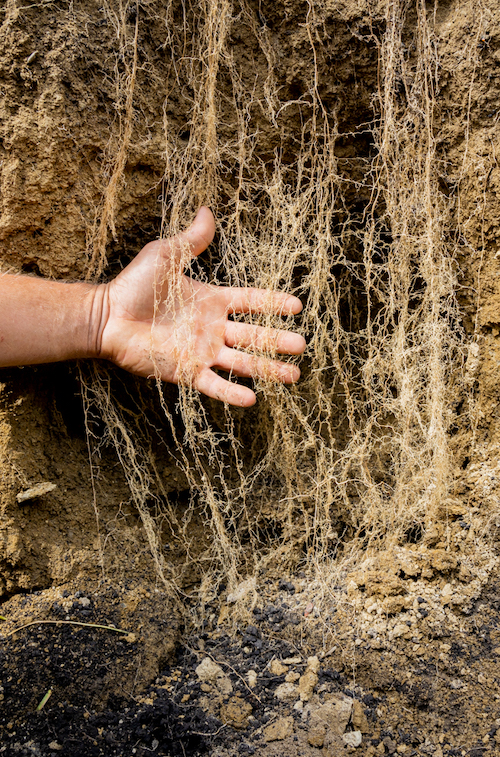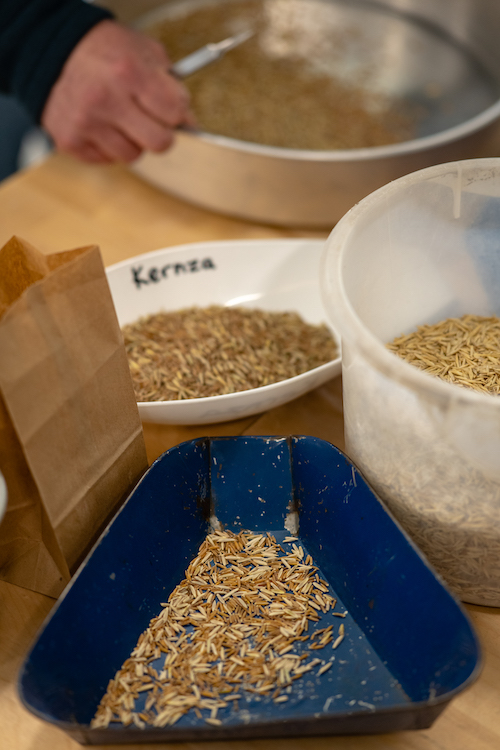What can you make with half a million pounds of Kernza? Try beer.
The frustration in Luke Peterson’s voice is palpable as he talks about how far he’s come — and how far there is to go — in getting Kernza into the marketplace. “We’ve been working at building this rotation that’s regenerating the soil,” says the Minnesota farmer of diversified regenerative organic grains and grassfed beef. “If farmers don’t grow it, it’s never going to get anywhere. But we’ve had our fair share of struggles in marketing it.”

Back in 2018, 10 years after it was made available to farmers, Peterson added Kernza, the trademark name for a cultivar of intermediate wheatgrass (Thinopyrum intermedium), to his already extensive crop rotation, which includes redeemer wheat and streaker oats, buckwheat and flax, two-row barley and einkorn. The draw: the promise of this perennial grain’s 12-foot taproot to enhance carbon storage, water infiltration and soil organic matter. And perhaps, one day — the dream of the team at The Land Institute, the agricultural research nonprofit that started developing Kernza 20 years ago — to introduce a crop longer-lived than the usual roster of annual grains to the landscape. According to Tessa Peters, The Land Institute’s director of crop stewardship, about 60 farmers are currently growing about 4,000 acres of Kernza across the U.S. The yield is almost half a million pounds per year.
But Kernza has a low yield that decreases over the three years it stays in the ground, says Peterson, resulting in prices much higher than other grains (not to mention making valuable farmland less and less productive and profitable for farmers, already contending with slim margins). Kernza also has high protein content and a small kernel size, both of which create challenges for processing and recipe development that have made commercializing it an uphill battle. An added sting — one still being felt by farmers — was a 2017 commitment from General Mills to incorporate Kernza into products like breakfast cereal, which evaporated after a couple of limited-edition releases. These days, says Peterson, “Nobody’s buying.”
Not quite nobody: The beer industry, with Patagonia Provisions in the lead, is a notable exception. “Recipe development on the brewing side is very flexible, which means breweries can go from R&D to having a product on the market within three to six months,” says Peters.
The ups and downs of brewing

You actually can find Kernza turning up in breads, crackers, cereals and flours produced by some small companies, like Breadtopia and Columbia County Bread and Granola. But beer is where the grain may be hitting its stride. The first commercially available canned Kernza beer was produced by Hopworks Urban Brewery, which partnered with Patagonia Provisions to launch a pale ale in 2016. Patagonia Provisions has since partnered with 11 more craft brewers to produce a series of lagers made with 15 to 40 percent Kernza, all of it from farmers who are growing it under the Regenerative Organic Certified label; the first beers in that collaboration were released simultaneously this past June. The hope from growers is that this activity will pique the interest of larger brewers and get more grain moving out the door.
“We’re trying to figure out, is there a market for it? Are there people interested in it? Can we malt it?” says Todd Olander, a farmer in Colorado who grows 2,000 acres of grain — including 10 acres of Kernza — for the brewing and distilling industries. (He also owns a malting facility.) As challenging as Kernza to grow, so, too, is the processing. Similar to an oat, a Kernza kernel has a hull, which requires “quite a bit of cleaning” to be removed, Olander explains. Additionally, its small size means it falls through the perforations at the bottoms of malting kettles designed to accommodate larger barley kernels. Malting Kernza “could be as simple as swapping out some screens and [experimenting] with some very small batches,” Olander says. But at the moment, most brewers are using it raw.
The challenges of scale
Sandy Boss Febbo, co-owner of Patagonia beer partner Bang Brewing in Saint Paul, Minnesota, defines the flavor of raw Kernza as “a little bit nutty, and it has some layers of spice to it.” Before this year’s lager release, she experimented with adding Kernza to 14 beer styles, including a blonde ale, a farmhouse ale and an India pale ale. Regulars to Bang Brewing’s taproom, she says, “have been with us for this whole journey and are really interested” in the story of Kernza — just as she’s committed to brewing with organic ingredients that “help in this situation of climate change that we’re in.”
The second batch of her current lager contains 17 percent Kernza — enough to allow customers to taste its “deliciousness” — and going forward, Boss Febbo will include at least 1 percent Kernza in all the company’s beers. Customers “may not be able to discern that the grain is present” at the lowest percentage, she admits. “But we can model recipe development for large regional macro-breweries, allowing us an opportunity to say, ‘You can tuck this into any beer.’” Further, she notes, if the big guys “added one percent Kernza to their beers, it would have a massive impact to support this grain.”
Even after six years, Boss Febbo still finds that working with Kernza presents challenges. For starters, “We have to take extra steps and extra time” to roll the grain, in order to release its starches and make them soluble. To crush Kernza, a roller mill designed for wheat and barley must be cranked all the way down to its tightest setting. “It’s a very slow move and not the most efficient thing,” Boss Febbo says. “We’re just specifically stubborn, and it’s worth it to us, but not every brewer is going to be willing to do it.” Distilling, she thinks, offers another promising avenue for Kernza — Tatersall Distilling recently released a Kernza whiskey, for example. But Peters points out that aged spirits like whiskey won’t do much to move the grain along more immediately.
Building markets

Alex Heilman is director of Mad Markets at Mad Agriculture, a nonprofit that boosts regenerative agriculture from multiple angles, including helping would-be Kernza farmers access financing through its sister organization Mad Capital. Mad Agriculture also handles marketing for the Perennial Promise Growers Cooperative, through which Peterson and other farmer-members sell their regenerative organic certified Kernza to Patagonia partner brewers and several others (as well as anyone else who wants to make products with the grain).
Heilman is trying to better commercialize Kernza and connect various dots along the supply chain. “We need to work to get this grain in a usable format so it’s not just, here’s a group of farmers over here, here’s a bunch of brewers that want to work with this grain,” he says. “There have to be food safety steps and processing and audit trails in between. We manage that whole process.”
When General Mills walked away from Kernza, Heilman says, “that had a devastating effect on market development and access.” And while there’s still a need for a similarly big player to volumize Kernza sales, smaller companies can keep farmers growing the crop while consumer packaged goods companies dawdle on the sidelines. Mad Agriculture’s role here, says Heilman, is to sell Kernza “in other formats that make it more accessible” to companies.
To that end, Mad Agriculture has begun to develop “true old-school partnership-style relationships” with mills in Minnesota and North Dakota. The nonprofit is also working out ways to educate customers, including basics like why hammer mills work better for turning Kernza into flour than stone mills; how toasting the grain first can help it grind faster; or how a higher protein content, Heilman explains, “could look fantastic on your nutrition panel.” When it comes to scaling up beer, he says, “We’re trying to unlock the ability to sell Kernza as a cracked grain so brewers don’t have to further process it themselves.”
Cost is still a prohibitive factor. Kernza sells for anywhere from $2.50 to $4.50 a pound. “When they’re used to buying grain for 30 to 50 cents a pound…That can be an immediate deal breaker,” Heilman says. “I don’t necessarily see the Coors of the world picking this up and being like, ‘Yeah, this is exactly what we want.’”
Nevertheless, 35 craft brewers have worked with Kernza to date, and with another 9,500 of them out there, Heilman says the future of Kernza beer has great potential. “Brewers are starting to understand that grains have terroir, that different taste notes can come out of unique grains grown in very specific regions.”
Bang Brewing’s Boss Febbo says creating a bigger market for Kernza beer is just a matter of time. “I’ve never been involved in bringing a new grain to market before, and it’s taught me to take a breath and have patience with it,” she says. “It’s not like no one’s working to make it happen. People’s life’s work is making this dream come true.”
Get the latest food news, from FoodPrint.
By subscribing to communications from FoodPrint, you are agreeing to receive emails from us. We promise not to email you too often or sell your information.
Top photo: A group tours the Kernza fields at A-Frame Farm. Photo credit: Amy Kumler.
More Reading
The case for cover crops goes beyond climate benefits
November 20, 2024
Vandana Shiva is still mad
October 2, 2024
Six unusual greens to try
September 4, 2024
Agroforestry’s role in wildlife conservation and food security
August 12, 2024
Cooking oils and sustainability
July 26, 2024
Sourcing more sustainable flowers
March 27, 2024
Seeds and sovereignty: 8 books on biodiversity in the food system
February 23, 2024
A rye renaissance is coming
January 12, 2024
The importance of traditional Hawaiian food systems after the Lahaina blaze
December 7, 2023
Seed saving as a living legacy
November 7, 2023
